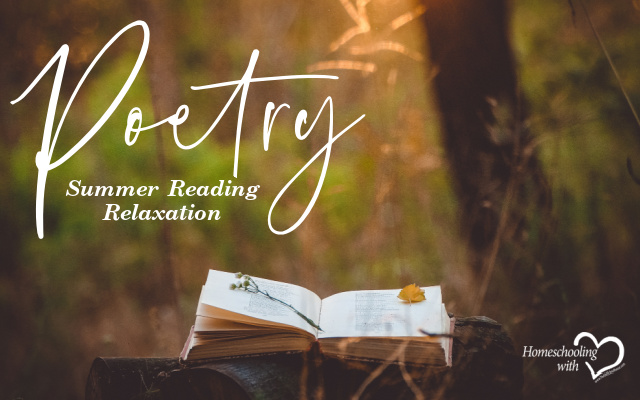Poetry – Summer Reading Relaxation


“Mary had a little lamb.
“Its fleece was white as snow
“Everywhere that Mary went,
“The lamb was sure to go.”
“Jesus loves me, this I know.
“For the Bible tells me so.
“Little ones to him belong.
“They are weak and he is strong.”
What do these familiar words have in common? They are both forms of poetry.
Too often we think of poetry as long, old, awkward phrases and sentences and probably Shakespeare. Maybe many of us only remember having to read poetry in school and having to write the meaning of it or analyze it or … gasp … write a poem. It never seemed a pleasant experience, right?
One writer lists “lack of exposure” as the number one reason people don’t like poetry. It’s not that we’ve not been exposed; it’s we haven’t had good experiences.
The relaxed times of summer are a good time to introduce your children to poetry. Well, maybe not introduce it because as seen above they already know poetry. It can be a good time to expand on that knowledge.
Our family maintained daily reading time during the summer. Because of the more relaxed nature, these hot days are a good time to read some simple and fun poems. Ogden Nash is known for his light-hearted little poems, such as “The Purple Cow.” These silly little poems have children laughing and asking for more.
Shel Silverstein wrote several books of children’s poetry including Where the Sidewalk Ends. Here’s a sample from Silverstein’s work “Colors:”
“My eyes are greyish blueish green, but I’m told they look orange in the night.”
(Shel Silverstein, Where the Sidewalk Ends: The Poems and Drawings of Shel Silverstein. Copyright 1974. https://internetpoem.com/shel-silverstein/colors-poem/)
Isn’t that the way children think?
After this easy introduction, you can begin to read more serious poetry. Read some of the classic hymns, verses to patriotic songs, or the beloved Psalms. What are similarities? What are differences? Do all of them rhyme? Have the same number of words per line? Or lines per verse?
Poetry also introduces unique ways of looking at words. Silverstein could have said, “My eyes are grey-green.” While accurate, the mundane approach doesn’t give the same visual representation as Silverstein’s words do. Poems seem to allow more freedom with words, helping our kids to expand their vocabulary. This in turn leads to more creative and thoughtful writing in other subjects.
Reading poems can often lead to unique ways of looking at words. Rather than the spelling or meaning, we can even look at the structure of a word as C. Dale Young does in the poem “The Bridge.” The first verse says
“I love the fact there are parallel lines
in the word “parallel,” love how
words sometimes mirror what they mean.”
(https://www.poetryfoundation.org/poems/58763/the-bridge-56d23d6e802bf)
Had you ever seen those parallel lines before? Neither had I.
It’s fun to act out poems. Again, this can be something silly and fun. Try being fog coming in on cat’s feet from Nash’s poem “Fog.” For extra fun with Nash poetry, find “Fleas” or “Purple Cow.” When read with drama, it will turn into a gigglefest.
It’s possible that before long, your kids will be bringing you little notes with poems about bugs, the sky, and “I love you, Mom.” Write little poems to them and leave them on their pillow. Be silly or serious. Write some “Roses are red” poems to them. They will return the favor.
Our family approached poetry as another form of writing, not something special. We read poetry as often as we read stories. Eventually we did read Shakespeare as a family, each person reading the dialogue aloud. The dreaded subject became a pleasurable family activity.
Poetry needn’t be a separate subject relegated to a few weeks during the school year with the obligatory ABAB rhyme pattern written at the end. Reading one poem a day is enough, if you can get away with it. Once our family started reading poetry, we couldn’t stop with just one.
What could be more relaxing than spending an afternoon somewhere cool and reading poetry together? (Yes, I know the kids may think the swimming pool is more inviting.) When approached casually and with fun during the non-school months, you and your children will gain an appreciation for this form of literature, painlessly.
Resources
Grammar of Poetry video lessons. For a review https://www.susankstewart.com/poetry-have-no-fear/
 Susan K. Stewart, Managing Editor with Elk Lake Publishing, teaches, writes, and edits nonfiction. Susan’s passion is to inspire readers with practical, real-world solutions. Her books include Science in the Kitchen, Preschool: At What Cost?, Harried Homeschoolers Handbook, and the award-winning Formatting e-Books for Writers. Her latest book, Donkey Devos: Listen When God Speaks, was released in July. You can learn more at her website www.susankstewart.com. Join Susan and other homeschoolers at Harried Homeschoolers Facebook group.
Susan K. Stewart, Managing Editor with Elk Lake Publishing, teaches, writes, and edits nonfiction. Susan’s passion is to inspire readers with practical, real-world solutions. Her books include Science in the Kitchen, Preschool: At What Cost?, Harried Homeschoolers Handbook, and the award-winning Formatting e-Books for Writers. Her latest book, Donkey Devos: Listen When God Speaks, was released in July. You can learn more at her website www.susankstewart.com. Join Susan and other homeschoolers at Harried Homeschoolers Facebook group.
—-
Science in the Kitchen https://www.susankstewart.com/books/science-in-the-kitchen/
Harried Homschoolers Handbook https://www.susankstewart.com/books/harried-homeschoolers-handbook/
Donkey Devos https://www.susankstewart.com/books/donkey-devos-listen-when-god-speaks/
Harried Homeschoolers Facebook group https://www.facebook.com/groups/harried.homeschoolers





















































